Sea Fishing in Saint Lucia.
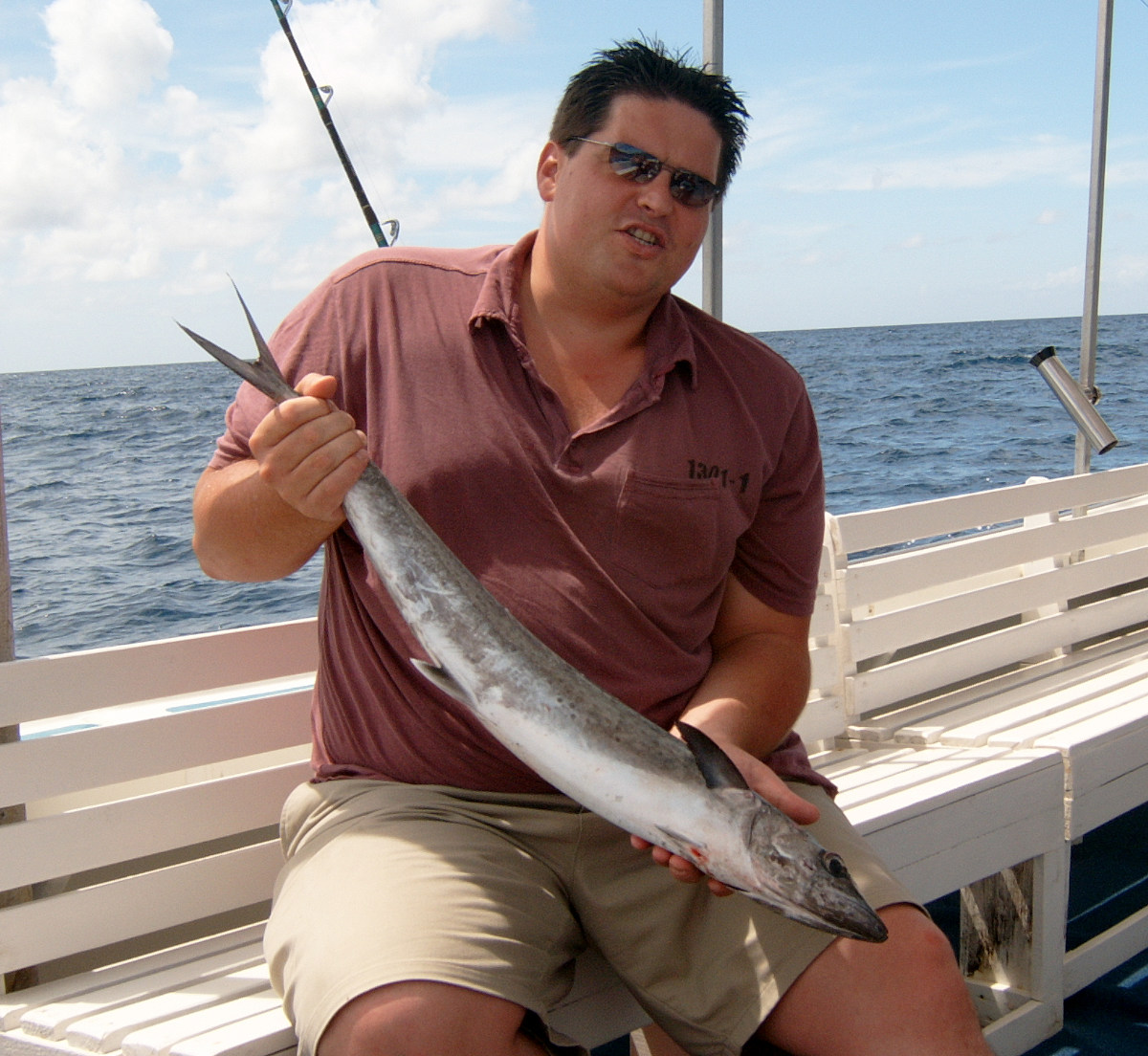
The volcanic island of St Lucia provides deep water game fishing within a few miles of the island. Lines can be in the water within 15 minutes of departure. You can expect to catch Dorado, Wahoo, blue Marlin and Tuna.
Table of Contents
Catches are not a guarantee though, it would be called catching and not fishing if it were.
Some care is required, Marlin are dangerous and one of the crew on my most recent charter had a lovely scar on his hand from a barracuda bite.
Does St Lucia have good fishing?
I have fished many places around the world and Saint Lucia's waters are some of the best.
St. Lucia has some of the steepest drop offs and deepest waters in the Caribbean. This up welling of currents and nutrients means there are many and varied species of fish available to catch all year round.
Fishing starts from around one mile offshore and may get as far as 10 miles out, depending on the season and weather conditions.
Below: The Caribbean sea.
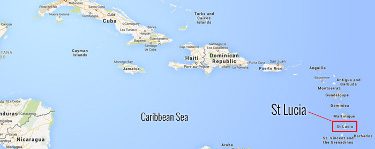
Although the island is quite small the the topography of the underwater environment make it ideal as a sport fishery.
Being small and having limited access makes
How much does sea fishing cost in Saint Lucia?
If you want to do more than fish from the shores you'll need a boat, either your own or a chartered vessel. You can get a half-day charter starting at about $450 (USD) for up to six people. A full day’s charter, up to eight anglers, can cost $3000 (USD) and usually lasts eight hours.
There even fly fishing for the purists amongst you. Whether you have been fishing for years and are a pro, or just an amateur or holiday maker wanting a little fun or a day out on the sea, or want to introduce your children to the thrill of sport fishing, fishing in St. Lucia offers you an experience like no other.
Visitors can enjoy several kinds of fishing while vacationing on St. Lucia. Rock and surf fishing, kite fishing, spear fishing, fly fishing, estuary fishing, and deep sea fishing are the most popular fishing ventures among anglers on the island.
Fishing Regulations on Saint Lucia:
Because fishing is such a popular sport on St. Lucia, it is important to remember a few things when angling in these waters. In order to preserve the Caribbean's fragile ecosystem, officials on the island promote a catch and release policy among fishermen.
Environmentally aware fishermen also remember not to throw waste overboard into the water so the seas of St. Lucia remain clear and clean.
Do you need a license to fish in St Lucia?
Visitors to the island do not need a licence but have to charter a registered fishing vessel.
A recreational fishing licence is issued to citizens or residents of Saint Lucia and allows an individual to fish from a vessel for recreational purposes between the hours of 8:00 a.m. - 4:30 p.m.
The waters off the coast of St. Lucia are filled with those trophy fish that most avid anglers have been in search of their whole lives. Please help preserve them for other anglers and future catches depend on large, older breeding fish in the waters.
Jigging results in trophy red snapper and grouper, and with deep water gear we can also target swordfish, the Caribbean is home to some of the best fishing grounds in the world.
Below: The seas around Saint Lucia still contain trophy fish like the huge Grouper.

St. Lucia has some of the deepest waters in the Caribbean, which allows for year-round fishing of all the varied, inhabitant species. Fishing adventures start approximately one mile offshore and the vessels may reach anywhere between six to eight 8 miles out, depending on fishing and weather conditions.
What fish can you catch in Saint Lucia?
Frequently caught species include:
- Blue Marlin,
- Sailfish,
- Yellow Fin and Black Fin Tuna,
- Dorado,
- Barracuda,
- King Mackerel and Spanish mackerel,
- Wahoo,
- Rainbow Runners,
- Horse Eye Jacks,
- Yellow Tail Snapper.
Up to 6 lines are trolled with both artificial lures and skirted ballyhoo rigs. All bill fish are catch and release unless reeled in dead or injured beyond the point of survival.
Below: Deep sea fishing for Red Snapper.
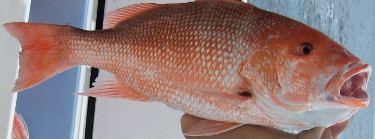
Yellow fin Tuna:
The yellow fin tuna is among the larger tuna species, reaching weights over 180 kg (400 lb), but is significantly smaller than the Atlantic and Pacific Blue fin tunas, which can reach over 450 kg 990 lb.
Yellow fin tuna are a popular sport fish in many parts of their range and are prised for their speed and strength when fought on rod and reel. Many anglers believe that large yellow fin are, pound for pound, the fastest and strongest of all big game tuna. Sport fishermen also prize the yellow fin tuna for its culinary qualities.
Below: Yellow fin Tuna.
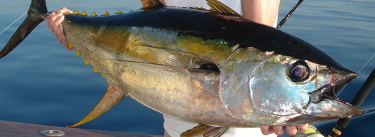
The main body is a very dark metallic blue, changing to silver on the belly, which has about 20 vertical lines.
Dorado:
Sometimes called mahi-mahi as well as a few other names, it has a world-wide distribution and is prolific. Because of this these fish can be found all over the world and are a commonly-caught species that give any angler a good fight and visual fireworks with their aerial acrobatics. Dorado are short lived but grow very fast. Because of their ability to constantly feed, the mahi-mahi is one of the fastest growing fish in the ocean. These fish are known to have a voracious appetite and are carnivorous feeders. They will often feed on flying fish, squid, mackerels, crabs and other fast swimming bait fish.
They can display a variety of different colours including bright turquoise, green, yellow and even purple and have an average size range of 34 to 55 inches (86 to 140 cm). The all-Tackle record Dorado weighed 87 lb (39.46 kg), so 50 lb tackle is quite sufficient.
Below: Male Dorado breaching the surface. Referred to as bulls will typically grow faster than their female counterparts and have a very pronounced forehead.
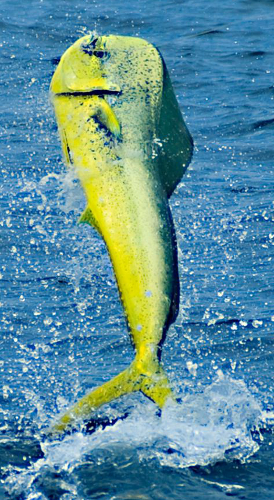
Debris such as floating boards, palm fronds or anything else that will provide shade and cover for smaller bait fish, will almost always provide a starting point for fishing.
If you happen to be lucky enough to find a large area of weeds or other floating debris, you should always take a close look and investigate the area. This can be accomplished by trolling a few baits or lures around the perimeter of the area or drifting next to the debris with frisky live baits.
If you don’t have any luck with the first few passes around the area, stop the boat and try getting some baits down deeper beneath the debris. Often times, fish will congregate deep beneath the area looking to pick up scraps that fish feeding at the surface have dropped and left for the predators below.
Blue Marlin:
The Atlantic blue marlin is a species that feeds on a wide variety of organisms near the surface. It uses its bill to stun, injure, or kill while knifing through a school of fish or other prey, then returns to eat the injured or stunned fish.
Marlin is a popular game fish. The relatively high fat content of its meat makes it commercially valuable in certain markets. It is the national fish of the Commonwealth of the Bahamas and is thus featured on its Coat of Arms.
Below: Marlin fishing off Saint Lucia.
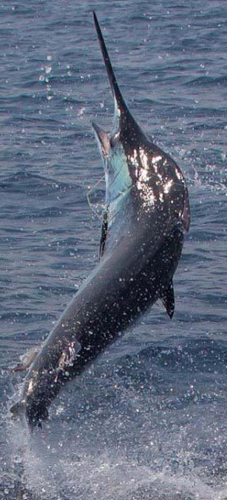
Adult blue marlin have few predators apart from man. They are sought after as a highly prised game fish by anglers and are taken by commercial fishermen, both as a directed catch and as by catch in major industrial tuna fisheries. Blue marlin are currently considered a threatened species by the IUCN due to over fishing so we ask all bill fish are released uninjured if possible.
Blue marlin are distributed throughout the tropical and subtropical waters of the Atlantic, Indian, and Pacific Oceans. A Blue water fish that spends the majority of its life in the open sea far from land, the blue marlin preys on a wide variety of marine organisms, mostly near the surface, often using its bill to stun or injure its preys.
Females can grow up to four times the weight of males. The maximum published weight is 818 kg (1,803 lb) and length 5 m or 16.4 ft.
The Wahoo:
Its body is elongated and covered with small, scarcely visible scales; the back is an iridescent blue, while the sides are silvery, with a pattern of irregular vertical blue bars and have razor sharp teeth.
These colours fade rapidly at death. The mouth is large, and both the upper and lower jaws have a somewhat sharper appearance than those of king or Spanish mackerel. Specimens have been recorded at up to 2.5 m (8 ft. 2 in) in length, and weighing up to 83 kg (183 lb). They are some of the fastest fish in the sea.
The Wahoo is different from the related Atlantic king mackerel the barracuda is sometimes confused with mackerel and Wahoo, but is easy to distinguish from the latter two species. Barracuda have prominent scales, larger, dagger-like teeth, and lack the caudal keels and blade-like tail characteristic of the mackerel.
Barracuda:
The barracuda is a ray-finned fish known for its large size and fearsome appearance. Its body is long, fairly compressed, and covered with small, smooth scales. Some species can reach up to 2.1 m (6.9 ft.) in length and 30 cm (12 in) in width.
Below: Barracudas are snake-like in appearance, with prominent, sharp-edged, fang-like teeth, much like piranhas, all of different sizes, set in sockets of their large jaws. They have large, pointed heads with an under bite in many species.
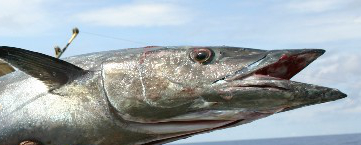
Barracudas are ferocious, opportunistic predators, relying on surprise and short bursts of speed up to 27 mph or 43 km/h to overtake their prey. Anyone catching a barracuda would be wise to wedge a wooden paddle in it's mouth as it has a ferocious bite
Are sharks common in Saint Lucia?
Blue reef sharks and other species are found in the island but are rarely seen or caught. I have never seen one in the shallows around the island.